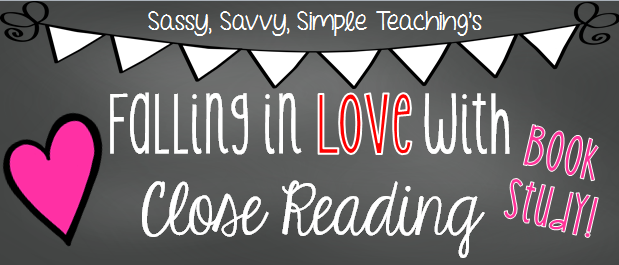“We can teach our students how to read closely and fall in love with reading.”
~Donalyn Miller July 2013
This quote is from the foreword of Falling in Love with Close Reading and it really stuck with me. I’m so excited to be joining with this group of fabulous educators to learn more about this strategy and how it can be used to create lifelong, independent readers. So let’s get started on Chapter 1…
What is Close Reading?
“Close reading is something we teach students to do rather than something we just do to them.” page 4
Close reading is reading carefully. While you’re reading carefully you’re also analyzing the text so you can make interpretations about that text. It’s reading with purpose and thought.
What is Powerful Close Reading Instruction?
It is explicit, repeated instruction over time and throughout the subjects. It is giving students the opportunity to apply those close reading skills learned in the classroom. I thought it was also important to note that this is only, “one piece of your reading instruction, not the only part of your instruction.”
The authors stress the importance of student engagement and joy in close reading as well. I found this refreshing because many other sources make close reading sound boring and more business-like rather than a skill that could be utilized in reading for entertainment. I understand that a big goal of CCSS is to prepare students for reading at a college level. However at my level students need to learn to engage in a text and analyze it. More importantly I’d like them to engage & analyze because they want to interact with the text not just because I want them to answer comprehension questions once they’re done. Powerful Close Reading Instruction creates engaged, independent readers.
What are We Currently Doing in Our Close Reading Instruction?
This past year I used some MAX teaching strategies to engage my 2nd grade students in close reading with National Geographic Magazines.
The two I used frequently were the 3-Level Study Guide and Pre/Post Vocabulary.
The 3-Level Study Guide has 3 levels of statements. The levels are Right There on the Page, Reading Between the Lines, and Reading Beyond the Lines. You find a complex text and then choose some statements the students will be focused on in their reading. Some of the statements are true and some are false. The students read the statements before they begin reading the text. Then as they read the text they mark evidence (we highlighted in different colors) that either supports or negates the statements.
The Pre/Post Vocabulary has 5-6 words in a list. Before the students read they mark their understanding of the words. Then they mark their understanding after we've read, analyzed, and discussed. The goal is for the students to improve their vocabulary skills.
Here is an example of how I altered the 3-Level Study Guide to fit the primary world.
The Pre/Post Vocabulary strategy on top of the leveled study guide so we were using comprehension and vocabulary strategies over a couple guided reading sessions. You can see I only did two levels on the study guide. I used Right There on the Page & Read Between the Lines. My 2nd graders were just getting used to close reading so I didn't want to overwhelm them. They did very well with these and it was awesome to hear the discussion that occurred. I would hear "Yes I agree with you because I see this sentence in the text." or "No, this one is wrong because..."
It took a lot of modeling, but it was worth it. They were engaged in the reading, discussing it at length, and for my higher students I saw an improvement in their independent reading.
I will be sharing the strategies I learn in Falling in Love with Close Reading in next week's post. I hope you'll come back. Thanks for stopping by...



I look forward to this discussion.
ReplyDeleteGreat Tammy! Check out tomorrow's post. It's all about using text evidence.
Delete